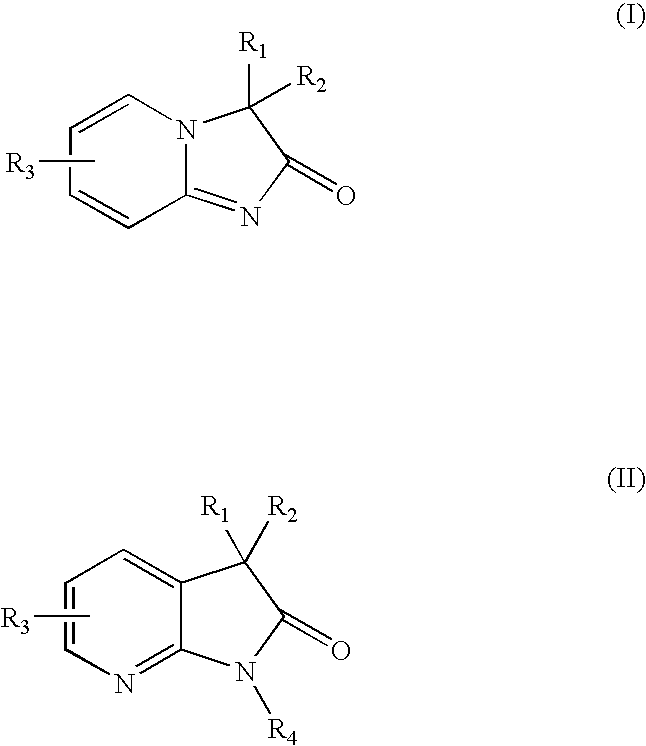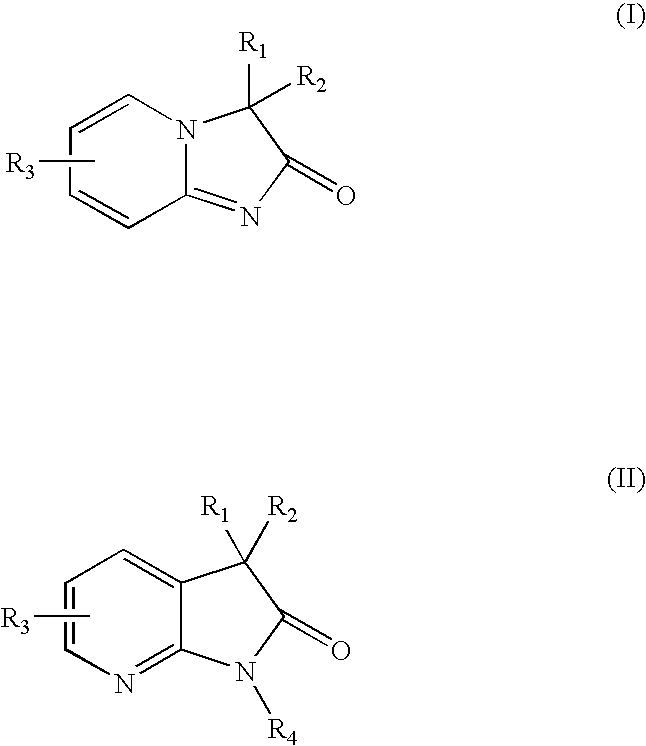Pyridine imidazoles and aza-indoles as progesterone receptor modulators
- Summary
- Abstract
- Description
- Claims
- Application Information
AI Technical Summary
Benefits of technology
Problems solved by technology
Method used
Image
Examples
example 1
A. 2-Amino-5-bromo-1-ethoxycarbonylmethyl-pyridinium; bromide
[0090]
[0091]2-Amino-5-bromopyridine (10.88 g, 62.9 mmol) was dissolved in acetone (65 mL). To this solution was added ethyl bromoacetate (7.7 mL, 69.2 mmol). The solution was heated to reflux overnight under nitrogen. The reaction mixture was cooled and an off-white solid was filtered off. The solid was washed with acetone and dried to provide title compound as an off-white solid (13.74 g, 64%). 1H NMR (DMSO-d6) δ 8.91 (s, 2H), 8.42 (d, J=2.2 Hz, 1H), 8.09 (dd, J=2.2 and 9.5 Hz, 1H), 7.10 (d, J=9.5 Hz, 1H), 5.11 (s, 2H), 4.21 (q, J=7.1 and 14.2, 2H), 1.26 (t, J=7.1, 3H); MS (m / e): 259 (MH+).
B. 6-Bromo-imidazo[1,2-a]pyridin-2-one
[0092]
[0093]To a solution of 2-Amino-5-bromo-1-ethoxycarbonylmethyl-pyridinium; bromide (2.86 g, 8.4 mmol) in methanol (30 mL) was added sodium methoxide (25 wt %, 2.5 mL, 10.1 mmol). The reaction mixture was stirred at room temperature overnight under argon. The reaction mixture was diluted with wa...
example 2
6-(3-Chloro-phenyl)-3,3-dimethyl-imidazo[1,2-a]pyridin-2-one
[0100]
[0101]To a round-bottom flask was added 6-bromo-3,3-dimethyl-imidazo[1,2-a]pyridin-2-one (60 mg, 0.25 mmol), 3-chlorophenylboronic acid (39 mg, 0.25 mmol), potassium carbonate (69 mg, 0.25 mmol), Pd(PPh3)4 (29 mg, 0.025 mmol), dioxane (5 mL) and water (1 mL). The mixture was heated at reflux until the starting material was consumed monitored by HPLC-MS. The solution was cooled and water was added. The reaction mixture was extracted twice with ethyl acetate and the combined organic layers were dried, filtered and concentrated. The residue was purified by column chromatography eluting with 5% methanol / dichloromethane to provide the desired product as an off-white solid (43 mg, 63%). 1H NMR (CDCl3) δ 7.84 (dd, J=1.8 and 9.1 Hz, 1H), 7.74 (s, 1H), 7.46-7.27 (m, 5H), 1.64 (s, 6H); MS (m / e): 273 (MH+); HRMS: calc'd MH+ for C15H13ClN2O 273.0794; found 273.0800.
example 3
6-(3-chloro-phenyl)-3,3-spiro[cyclohexane]-imidazo[1,2-a]pyridin-2-one
[0102]
[0103]The title compound was prepared in 71% yield according to the procedure described in Example 2, starting from 6-bromo-3,3-spiro[cyclohepane]-imidazo[1,2-a]pyridin-2-one and the corresponding boronic acid. 1H NMR (CDCl3) δ 7.81 (dd, J=2.1 and 9.2 Hz, 1H), 7.76 (d, J=1.4, 1H), 7.45-7.33 (m, 3H), 7.25-7.23 (m, 2H), 2.40-2.30 (m, 2H), 2.05-2.00 (m, 2H), 1.91-1.86 (m, 1H), 1.78-1.71 (m, 4H), 1.49-1.42 (m, 1H); MS (m / e): 313 (MH+).
PUM
| Property | Measurement | Unit |
|---|---|---|
| temperature | aaaaa | aaaaa |
| temperature | aaaaa | aaaaa |
| temperature | aaaaa | aaaaa |
Abstract
Description
Claims
Application Information
 Login to View More
Login to View More - R&D
- Intellectual Property
- Life Sciences
- Materials
- Tech Scout
- Unparalleled Data Quality
- Higher Quality Content
- 60% Fewer Hallucinations
Browse by: Latest US Patents, China's latest patents, Technical Efficacy Thesaurus, Application Domain, Technology Topic, Popular Technical Reports.
© 2025 PatSnap. All rights reserved.Legal|Privacy policy|Modern Slavery Act Transparency Statement|Sitemap|About US| Contact US: help@patsnap.com



